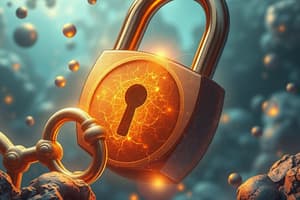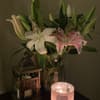Podcast
Questions and Answers
What does the y-intercept represent in a double reciprocal plot?
What does the y-intercept represent in a double reciprocal plot?
- Km
- Negative Km
- Vmax (correct)
- Slope of the curve
In a double reciprocal plot, the x-intercept is equal to negative one over Vmax.
In a double reciprocal plot, the x-intercept is equal to negative one over Vmax.
False (B)
What is the relationship between the slope of the double reciprocal plot and the constants Km and Vmax?
What is the relationship between the slope of the double reciprocal plot and the constants Km and Vmax?
Slope is equal to Km over Vmax.
In competitive inhibition, the inhibitor competes with the substrate for the ________ site.
In competitive inhibition, the inhibitor competes with the substrate for the ________ site.
Match the following terms with their correct descriptions:
Match the following terms with their correct descriptions:
Which of the following accurately describes the induced fit model of enzyme activity?
Which of the following accurately describes the induced fit model of enzyme activity?
The lock and key model suggests that the enzyme and substrate have a perfect fit without any structural changes.
The lock and key model suggests that the enzyme and substrate have a perfect fit without any structural changes.
What is the role of an enzyme in a biochemical reaction?
What is the role of an enzyme in a biochemical reaction?
In the lock and key model, the enzyme and substrate are considered to be __________.
In the lock and key model, the enzyme and substrate are considered to be __________.
Match the following terms with their definitions:
Match the following terms with their definitions:
Which model accounts for the deficiencies of the lock and key model by incorporating conformational changes of the enzyme during substrate binding?
Which model accounts for the deficiencies of the lock and key model by incorporating conformational changes of the enzyme during substrate binding?
In enzyme kinetics, enzymes are consumed in the reaction, which limits their activity.
In enzyme kinetics, enzymes are consumed in the reaction, which limits their activity.
Explain what happens to the enzyme in the induced fit model upon substrate binding.
Explain what happens to the enzyme in the induced fit model upon substrate binding.
What does a larger Michaelis constant (Km) indicate regarding enzyme-substrate affinity?
What does a larger Michaelis constant (Km) indicate regarding enzyme-substrate affinity?
A smaller value of Km implies a greater affinity of the enzyme for the substrate.
A smaller value of Km implies a greater affinity of the enzyme for the substrate.
In the context of enzyme kinetics, what does Vmax represent?
In the context of enzyme kinetics, what does Vmax represent?
At low substrate concentrations, enzyme velocity is ______ to substrate concentration.
At low substrate concentrations, enzyme velocity is ______ to substrate concentration.
Match the following terms with their descriptions:
Match the following terms with their descriptions:
What happens to the velocity of an enzyme reaction as substrate concentration increases beyond Km?
What happens to the velocity of an enzyme reaction as substrate concentration increases beyond Km?
The Lineweaver-Burk plot is useful in determining Vmax and Km.
The Lineweaver-Burk plot is useful in determining Vmax and Km.
What occurs to Km when the substrate concentration is much greater than Km?
What occurs to Km when the substrate concentration is much greater than Km?
In enzyme kinetics, when velocity approaches its maximum, it is said to be ______ the Vmax.
In enzyme kinetics, when velocity approaches its maximum, it is said to be ______ the Vmax.
Match the following enzyme behaviors with the correct terms:
Match the following enzyme behaviors with the correct terms:
What effect does a competitive inhibitor have on the Km of an enzyme?
What effect does a competitive inhibitor have on the Km of an enzyme?
A competitive inhibitor does not affect the Vmax of an enzyme.
A competitive inhibitor does not affect the Vmax of an enzyme.
What happens to the affinity of an enzyme for its substrate when a competitive inhibitor is present?
What happens to the affinity of an enzyme for its substrate when a competitive inhibitor is present?
In the presence of a competitive inhibitor, a higher concentration of _______ is needed to reach the same Vmax.
In the presence of a competitive inhibitor, a higher concentration of _______ is needed to reach the same Vmax.
Match each term with its correct description:
Match each term with its correct description:
Which of the following graphs represents the effect of a competitive inhibitor?
Which of the following graphs represents the effect of a competitive inhibitor?
Which part of the Michaelis-Menten equation represents the maximum velocity of the reaction?
Which part of the Michaelis-Menten equation represents the maximum velocity of the reaction?
The Lineweaver-Burk plot can be used to determine the effects of a competitive inhibitor.
The Lineweaver-Burk plot can be used to determine the effects of a competitive inhibitor.
The Michaelis constant (Km) is directly related to enzyme-substrate binding affinity.
The Michaelis constant (Km) is directly related to enzyme-substrate binding affinity.
What is the significance of Km in enzyme kinetics?
What is the significance of Km in enzyme kinetics?
In enzyme kinetics, competitive inhibitors block the _______ site, preventing substrate binding.
In enzyme kinetics, competitive inhibitors block the _______ site, preventing substrate binding.
Name the two main steps in the Michaelis-Menten kinetics.
Name the two main steps in the Michaelis-Menten kinetics.
In Michaelis-Menten kinetics, the binding step is considered ______ while the catalytic step is considered ______.
In Michaelis-Menten kinetics, the binding step is considered ______ while the catalytic step is considered ______.
How does the presence of a competitive inhibitor alter the reaction velocity versus substrate concentration curve?
How does the presence of a competitive inhibitor alter the reaction velocity versus substrate concentration curve?
Match the following terms related to Michaelis-Menten kinetics with their descriptions:
Match the following terms related to Michaelis-Menten kinetics with their descriptions:
What does a high Km value indicate about the enzyme's binding affinity?
What does a high Km value indicate about the enzyme's binding affinity?
The Michaelis-Menten model is the only model used to describe enzyme kinetics.
The Michaelis-Menten model is the only model used to describe enzyme kinetics.
What is represented by the term 'substrate concentration' in the Michaelis-Menten equation?
What is represented by the term 'substrate concentration' in the Michaelis-Menten equation?
In the Michaelis-Menten equation, the velocity of catalysis is given by the formula ______.
In the Michaelis-Menten equation, the velocity of catalysis is given by the formula ______.
What graphical representation is used to simplify the analysis of enzyme kinetics?
What graphical representation is used to simplify the analysis of enzyme kinetics?
What is the main difference between the lock and key model and the induced fit model?
What is the main difference between the lock and key model and the induced fit model?
The lock and key model accurately describes enzyme behavior during all circumstances.
The lock and key model accurately describes enzyme behavior during all circumstances.
What happens to the enzyme's active site upon substrate binding in the induced fit model?
What happens to the enzyme's active site upon substrate binding in the induced fit model?
In the lock and key model, the enzyme and substrate are considered to be __________.
In the lock and key model, the enzyme and substrate are considered to be __________.
Match the following models with their characteristics:
Match the following models with their characteristics:
Why is the induced fit model more accepted than the lock and key model?
Why is the induced fit model more accepted than the lock and key model?
Enzymes in both models are consumed in chemical reactions.
Enzymes in both models are consumed in chemical reactions.
What feature of the induced fit model enhances the enzyme's function?
What feature of the induced fit model enhances the enzyme's function?
What does the slope of the double reciprocal plot represent?
What does the slope of the double reciprocal plot represent?
In a double reciprocal plot, the y-intercept represents Km.
In a double reciprocal plot, the y-intercept represents Km.
What is the relationship between the x-intercept and Km?
What is the relationship between the x-intercept and Km?
The competitive inhibitor competes with the substrate for the __________.
The competitive inhibitor competes with the substrate for the __________.
Match the following terms with their corresponding definitions:
Match the following terms with their corresponding definitions:
Which statement best describes competitive inhibition?
Which statement best describes competitive inhibition?
The x-intercept of a double reciprocal plot can have negative values.
The x-intercept of a double reciprocal plot can have negative values.
What mathematical relationship can be derived from the least squares analysis of a double reciprocal plot?
What mathematical relationship can be derived from the least squares analysis of a double reciprocal plot?
In competitive inhibition, the presence of a competitive inhibitor requires a __________ concentration of substrate to reach Vmax.
In competitive inhibition, the presence of a competitive inhibitor requires a __________ concentration of substrate to reach Vmax.
Which of the following values is associated with the y-intercept in a double reciprocal plot?
Which of the following values is associated with the y-intercept in a double reciprocal plot?
What happens to the velocity of an enzyme-catalyzed reaction when substrate concentration equals Km?
What happens to the velocity of an enzyme-catalyzed reaction when substrate concentration equals Km?
The double reciprocal plot is also known as the Lineweaver-Burk plot.
The double reciprocal plot is also known as the Lineweaver-Burk plot.
What does Km represent in enzyme kinetics?
What does Km represent in enzyme kinetics?
In the Lineweaver-Burk plot, the x-axis represents ________ of substrate concentration.
In the Lineweaver-Burk plot, the x-axis represents ________ of substrate concentration.
Match the following enzyme activity parameters with their meanings:
Match the following enzyme activity parameters with their meanings:
Which statement is true regarding substrate concentration and Km?
Which statement is true regarding substrate concentration and Km?
In the double reciprocal plot, a higher slope indicates a lower Km value.
In the double reciprocal plot, a higher slope indicates a lower Km value.
What is the primary benefit of using the Lineweaver-Burk plot?
What is the primary benefit of using the Lineweaver-Burk plot?
When plotting the double reciprocal of the Michaelis-Menten equation, the equation is rearranged to show ________ versus ________.
When plotting the double reciprocal of the Michaelis-Menten equation, the equation is rearranged to show ________ versus ________.
Which of the following best describes what happens when the substrate concentration is much greater than Km?
Which of the following best describes what happens when the substrate concentration is much greater than Km?
What happens to the Vmax in the presence of a non-competitive inhibitor?
What happens to the Vmax in the presence of a non-competitive inhibitor?
Km is affected by non-competitive inhibitors.
Km is affected by non-competitive inhibitors.
What effect does a non-competitive inhibitor have on enzyme catalysis?
What effect does a non-competitive inhibitor have on enzyme catalysis?
With the presence of a non-competitive inhibitor, the Km remains __________.
With the presence of a non-competitive inhibitor, the Km remains __________.
Match the components with their effects related to non-competitive inhibition:
Match the components with their effects related to non-competitive inhibition:
What happens to the Km when a competitive inhibitor is present?
What happens to the Km when a competitive inhibitor is present?
A competitive inhibitor affects the maximum velocity (Vmax) of an enzyme.
A competitive inhibitor affects the maximum velocity (Vmax) of an enzyme.
What is the relationship between substrate concentration and the ability to reach saturation in the presence of a competitive inhibitor?
What is the relationship between substrate concentration and the ability to reach saturation in the presence of a competitive inhibitor?
In competitive inhibition, the inhibitor binds to the __________ site of the enzyme.
In competitive inhibition, the inhibitor binds to the __________ site of the enzyme.
Match the following outcomes with their corresponding effects of competitive inhibition:
Match the following outcomes with their corresponding effects of competitive inhibition:
How does a competitive inhibitor influence enzyme-substrate binding?
How does a competitive inhibitor influence enzyme-substrate binding?
Km is inversely related to the affinity of an enzyme for its substrate.
Km is inversely related to the affinity of an enzyme for its substrate.
What does the term 'inhibitor' refer to in the context of enzyme kinetics?
What does the term 'inhibitor' refer to in the context of enzyme kinetics?
As the concentration of a competitive inhibitor increases, the chances of the substrate binding to the enzyme __________.
As the concentration of a competitive inhibitor increases, the chances of the substrate binding to the enzyme __________.
Which of the following correctly describes the effect of a competitive inhibitor on a velocity vs. substrate concentration curve?
Which of the following correctly describes the effect of a competitive inhibitor on a velocity vs. substrate concentration curve?
Flashcards are hidden until you start studying
Study Notes
Enzyme Models
-
Lock and Key Model:
- Established model proposing that the enzyme's active site is a perfect fit for its substrate.
- Allows the enzyme to catalyze the conversion of substrate into product repeatedly without being consumed.
-
Induced Fit Model:
- More accepted model correcting shortcomings of the lock and key model.
- Proposes that the active site undergoes a conformational change upon substrate binding, creating a perfect fit.
- This model lowers the energy of the enzyme-substrate complex, facilitating lower activation energy for reactions.
Michaelis-Menten Kinetics
-
Describes enzyme-catalyzed reactions in two steps:
- Step 1: Formation of enzyme-substrate complex through reversible binding.
- Step 2: Irreversible conversion of substrate to product and release from the enzyme.
-
Velocity Equation:
- Velocity (V) = (Vmax × [S]) / (Km + [S]), where [S] is substrate concentration, and Km is the Michaelis constant.
-
Michaelis Constant (Km):
- Inversely related to the affinity of the enzyme for its substrate; higher Km indicates lower affinity.
- Competitive inhibition raises Km since the inhibitor competes for the same active site, requiring more substrate to achieve binding.
Inhibition Types
- Competitive Inhibition:
- Inhibitor competes with substrate for binding to the active site.
- Increases Km but does not affect Vmax: more substrate needed to reach saturation.
Graphical Representation
-
Velocity vs. Substrate Concentration:
- At low [S], V increases linearly (proportional to substrate concentration).
- At high [S], the graph approaches Vmax as substrate saturation is reached.
-
Lineweaver-Burk Plot:
- Double reciprocal plot of 1/V vs. 1/[S] yields a straight line.
- Y-intercept = 1/Vmax; X-intercept = -1/Km; slope = Km/Vmax, useful for determining Vmax and Km from experimental data.
Key Takeaways
- Enzymes act by lowering activation energy and are not consumed in reactions.
- Induced fit model is preferred for explaining enzyme action.
- Michaelis-Menten kinetics provide important insights into enzyme behavior and inhibition effects, particularly for competitive inhibitors.
Enzyme Models
-
Lock and Key Model:
- Enzyme and substrate are perfectly complementary.
- The substrate fits perfectly into the enzyme’s active site.
- Enzymes act as catalysts, converting substrates to products without being consumed.
- Does not account for energy dynamics affecting activation energy.
-
Induced Fit Model:
- The active site is not a perfect fit initially.
- Binding of the substrate induces a conformational change in the enzyme.
- Results in a better fit, allowing for efficient catalysis.
Michaelis-Menten Kinetics
-
Km (Michaelis constant):
- Indicates the substrate concentration at which the reaction rate is half of Vmax.
- Both substrate concentration and Km share the same units (concentration).
- When substrate concentration equals Km, velocity is at half Vmax.
-
Velocity vs. Substrate Curve:
- The graph demonstrates the relationship between reaction velocity and substrate concentration.
- Vmax is the maximum reaction velocity achievable.
- Km can be approximated by finding the substrate concentration at half Vmax.
-
Double Reciprocal Plot (Lineweaver-Burk Plot):
- Necessary for determining Vmax and Km using linear regression.
- Y-intercept represents 1/Vmax, while X-intercept gives -1/Km.
- Slope of the line represents Km/Vmax.
Enzyme Inhibition
-
Competitive Inhibition:
- The inhibitor competes with the substrate for the active site; only one can bind at a time.
- Km increases, indicating lower affinity for the substrate due to competition.
- Vmax remains unchanged when enough substrate is added to outcompete the inhibitor.
-
Non-Competitive Inhibition:
- The inhibitor binds to an alternative site, causing a conformational change that reduces enzyme activity.
- Km remains unchanged, as the substrate's affinity is not altered.
- Vmax decreases since the enzyme is less effective at catalyzing the reaction, independent of substrate concentration.
Important Graph Insights
-
Competitive Inhibition Graph:
- Higher substrate concentrations are needed to reach the same Vmax compared to the uninhibited enzyme.
- Graphically demonstrates increased Km while retaining the same Vmax.
-
Non-Competitive Inhibition Graph:
- Vmax is lower even with increased substrate concentrations.
- Both curves intersect at the same Km value; however, Vmax decreases.
Key Takeaways
- Understand the differences between competitive and non-competitive inhibition in terms of effects on Km and Vmax.
- Recognize how to interpret velocity, substrate concentration graphs, and double reciprocal plots for kinetic analysis.
Studying That Suits You
Use AI to generate personalized quizzes and flashcards to suit your learning preferences.




